Test: Veenhuis Ecovac 10,000
 Right-hand side filling pod with auto-fill arm
Right-hand side filling pod with auto-fill arm

 Arrow with float to indicate tank level instead of sight bulbs or tube
Arrow with float to indicate tank level instead of sight bulbs or tube

 In-line discharge turbo and flow valve and option of flow metre
In-line discharge turbo and flow valve and option of flow metre

 Left-hand side manual fill/connection
Left-hand side manual fill/connection

 Pressure gauges visible from the cab while filling/spreading
Pressure gauges visible from the cab while filling/spreading


|
|
Right-hand side filling pod with auto-fill arm
|

|
|
Arrow with float to indicate tank level instead of sight bulbs or tube
|

|
|
In-line discharge turbo and flow valve and option of flow metre
|

|
|
Left-hand side manual fill/connection
|

|
|
Pressure gauges visible from the cab while filling/spreading
|
Effective slurry management is key. Farm Trader takes a look at the Veenhuis Ecovac 10,000 and Eurojet 3000 in action
.gif)
With a diverse array of systems and machinery to choose from, it’s important to know the ins and outs of various machinery to determine whether it suits your specific farming methods and requirements.
One particular set-up that caught our attention was the Veenhuis Ecovac 10,000-litre tanker, fitted with a three-metre Euroject disc injector, from Farmchief, which we put to work on a Waikato goat farm to see it first-hand in action.
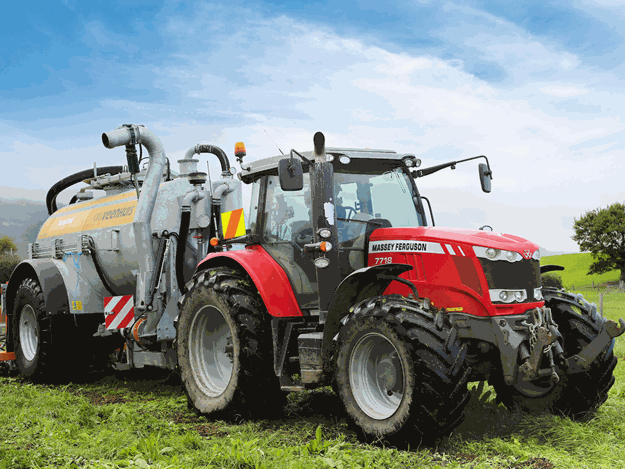
Most dairy farms have travelling irrigator type systems set up on a portion of the farm, with the nutrient storage pond, tank, bladder, and ability to manage the liquid nutrient spreading over a set area. What a tanker brings to the table is the advantage of being able to apply the nutrients anywhere on the farm where you can safely operate a tractor.
Operation
First impressions are of a well-constructed machine (as you’d expect from Veenhuis, which has a long-time reputation for quality slurry machines). Hooking up to the Veenhuis tanker is straightforward, as they are available with a standard hitch or K80 ball. Other options include steering drawbars and hydraulic weight transfer from the tanker to the tractor to provide extra traction.
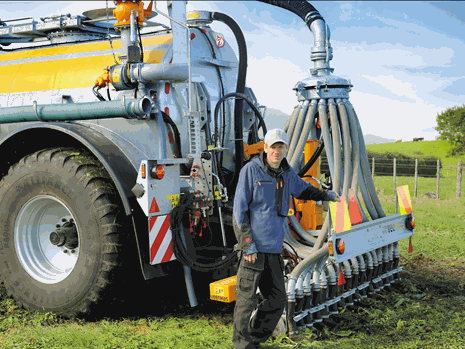 |
|
Mark Fouhy checking on the Veenhuis machine’s progress
|
In theory, a 100hp tractor is sufficient to operate a 10,000-litre tanker like our test machine. On the day of our testing, we had a 200hp Massey Ferguson providing the power, which did the job more than nicely, particularly given that we were operating on typical rolling Waikato farm terrain.
With more than 80 years’ experience manufacturing slurry equipment, build quality on the Veehnuis test tanker receives an A+. Smart design allows the ease of adding extras such as drawbar suspension by simply replacing the manual adjuster of the standard spec like the test machine. The galvanised finish top to bottom on the tanker makes a lot of sense given its hard-working role on a day-to-day basis, and the injector receives the yellow paint job of the higher-spec Profi tanks.
Filling is also an easy process, thanks to the eight-inch auto fill arm mounted on the right side of the tanker. The arm is long enough to give the tractor and tanker enough distance from the filling dock, allowing it to be near the edge of a pond if necessary. The filling dock secures to the underside of the tank when not in use, with storage for suction pipes on both sides of the tank.
 |
|
Minimal damage to existing pasture, thanks to disc injection
|
The main in-cab control switches between pump and suck on top of the vacuum pump with a small hydraulic ram. Once changed into suck mode, the other small joystick comes into use for raising and lowering the suction arm into the loading dock and opening or closing the valve to allow the tank to fill. Veenhuis tankers fill from the bottom, with the theory behind this being that the whole tank is methodically filled this way to avoid ending up with froth and a partially filled tank.
Internal baffles help to minimise the load sloshing around and prevent any issues with stability. I didn’t put a stopwatch on the time taken to fill, however, time spent at the pond was minimal, with the high capacity vacuum pump filling the tanker pretty quickly. As you’d expect, safeguards are built in to avoid damage to the pump, which should ensure plenty of trouble-free hours of pumping with minimal downtime and repairs.
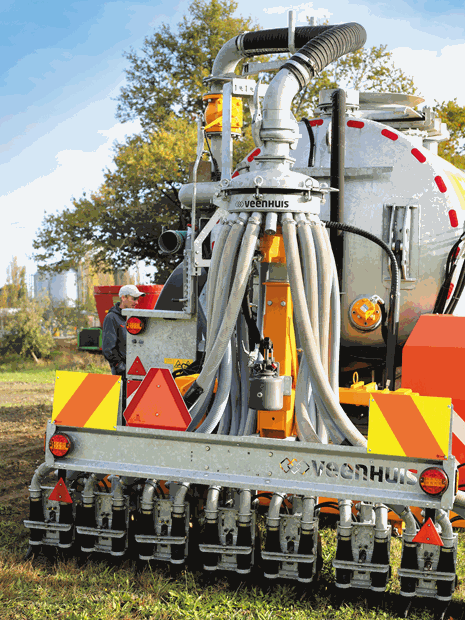 |
|
Euro spec, standard with marker boards and lighting front and rear
|
Other pump options are available for different situations, but most are more expensive than a standard vacuum pump. The efficiency of using a tanker depends greatly on the fill and spreading time, which will remain almost constant with the travel time the variable. The only way to really improve efficiency is to spread faster, operate a larger tank, or decrease the time spent between pond and paddock. This is where the capabilities of the Veenhuis are an absolute asset and there’s a large variety of tank sizes available, from 8000 to 34,000 litres.
The single axle, with large 800 60R/32 tyres, helps spread the weight of the tanker. Manoeuvrability is also very good, without the cost of another set of tyres and rear steering axle. When you get to the intended application area, it’s as simple as just holding the switch to change from suction to pumping. A three-stage switch then lowers the injector bar, opens the hydraulic shut off valves, and starts spreading. Hold the switch the other way and it will shut off the application and lift the implement back up – it could hardly be simpler!
 |
|
Three piece cutting disc, with +/- 15-degree movement from centre and hydraulic down pressure ensure a clean finish
|
If you require greater accuracy (technology), each injector can have pneumatic shut off valves linked into the ISOBUS touchscreen monitor and controller and be connected to GPS for the ultimate in accuracy and placement.
As a contractor, for me the flow rate valve system option that ensures consistent application even with varying ground speed would be a valuable tool to add on. Like all machinery, all non-standard extras come at a cost, and although being a high-quality brand, Veenhuis base models are not cheap, the long-term investment does make sense when you factor in performance, quality, and ease of use.
The machine we tested comes standard with front and rear lighting and over width panels. As well, the injector bar has lights that plug directly into the tanker, so it’s all set and ready for safe road operation. Options slightly different to the standard tank featured on this test machine include the hydraulic top opening hatch, which allows you to fill from the top of the tank should you need to. Making this machine even more usable is being able add other things to the tank – for example, seed, allowing you to get your nutrient spread and under sowing done at the same time.
 |
|
Hydraulic shutoff of each injector
|
Spreading equipment
Veenhuis tankers are available with a variety of different spreading attachments. Our test machine was fitted with a top-of-the-line three-meter Euroject disc injector.
The disc system comprises a unique three-disc system, designed to stay sharp as it wears. It also offers cost savings by providing the option of replacing only the 350mm cutting discs as they wear. Discs are mounted in gangs of two: 16 discs in total, spaced at 190mm, which gives a good even coverage across the working width of the machine. The discs are mounted on a hydraulic parallelogram, with the rubber injection boot-mounted directly behind the disc. The hydraulic system uses a large ram equal in size to the total of the eight rams on the injector discs to allow for undulations and bumps across the paddock.
 |
|
Minimal slurry nutrient left on the surface and plants, with previous solid waste spread still visible
|
The other notable feature is the 15 degrees movement (approximately) either side of centre to allow easier turns through corners without lifting out or tearing the paddock up. This is an area where the Euroject really excelled. Judging on the performance of our test drive, pasture damage using this system will be minimal. We were working in a large area of mixed pasture of around three to four centimetres. I think with this system, ideally, you’d want to be following the cows or adding nutrients back in after silage has been harvested, although, it would also slice through long pasture with no problems should that be what is required.
Depending on your application rate, when we tested the machine, we still got a little bit of nutrient left on the pasture but the amount was minimal and probably no issue at all in cow farm situation (especially in comparison to other spreading options).
In a goat farming cut and carry system, however, a little more adjustment would be required to be 100% confident it wasn’t going to cause any issues. The one niggly aspect of the disc injector was its width: at three metres, it tucked in tidily behind the tanker and you could not see it. I would look at one or two options to overcome this: perhaps a reversing camera to see what’s happening (and for added safety on the road) or a slightly wider injector (four metres would be sufficient and cover an extra metre with each pass).
 |
|
Discussing the result of the slurry injection with farmer
|
Why inject?
As I mentioned earlier, most dairy farms have travelling irrigator set-ups in place already. In the tanker equivalent, this is pretty much splash plate spreading. Studies have shown around 70% of nitrogen to be lost using this method. Trailing shoe/dribble bars losses are more around 30% loss of nitrogen applied, which is nowhere near as detrimental to pasture or as likely to have cows turn their noses up at the pasture in comparison to a splash plate spread paddock.
Nutrients injected will have minimal losses, around 10% of N with maximum uptake from the pasture of these nutrients. If you were to put a price on the difference of N applied, being approximately 60% less when applied via splash plate versus the injection system, any extra costs for application would soon be negated with the better use of recycling on farm nutrients rather than heading off to the fert store and buying more in a bag. The other two main benefits of injecting include no odour (so no upset neighbours) and also the fact that being injected, it’s out of sight, so there’s nothing to see.
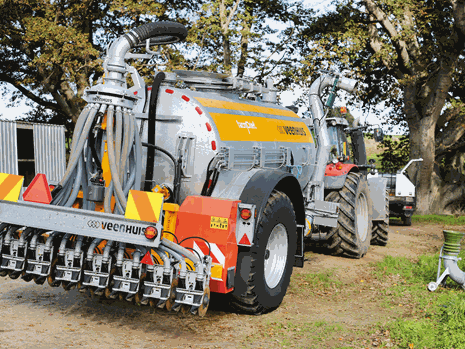 |
|
Ready for another fill at the pond
|
Veenhuis
While New Zealand is at the forefront of grass-based agriculture, when it comes to intensive agriculture, Europe is the place to go. Veenhuis is a Dutch company, based in Holland, where sea levels are higher than the land. Effective use of nutrients is vital, and with more than 80 years in the business, the Veenhuis tankers are designed to stand the test of time. Available in the galvanised finish like our test machine, or in the bright yellow of the Profi-line models, there are plenty of options to choose from in terms of additional extras.
Much like a new tractor, if you’re after a specific tanker to do a certain job, it’s possible to order the tanker with the exact requirements you want and the team at Farmchief – who are New Zealand distributors for Veenhuis – are more than helpful when it comes to ensuring the right tools for the job. As well as the range of Veenhuis tankers, Farmchief can fit the right application attachment or offer the Rotomax pump and pipe system, which is an impressive sight to see in action, as a different alternative to manage nutrient application.
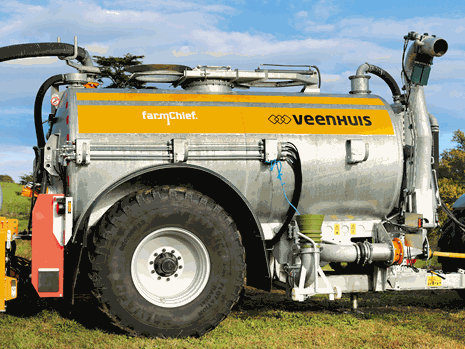 |
|
Large 800/60R32 tyres to spread the weight of the machine for minimal compaction
|
Summary
All in all, after our day testing the Veenhuis 10,000-litre Ecovac tanker and Euroject 3000 slurry injector, I was well impressed with the quality of the machine. One of the most notable features for me was the tidy, finished job, without any pasture carved up or coated excessively in nutrients, which would make pasture unpalatable to stock for some time.
With the effluent neatly sliced into the ground to make the most of its valuable nutrients, any issues around ponding and odour should be next to nil, as long as common sense is used with application timing and rates.
I’d say this Veenhuis Ecovac unit would suit a dairy farm wanting to confidently handle their own nutrient spreading, as well as an agricultural contractor.
I believe the need to improve the utilisation of nutrients is going to be crucial going forward. The cost savings on purchased nutrients as well as environmental benefits will be a major consideration, as well as being important to remain profitable and sustainable. The large range available from Veenhuis means a machine with the specifications to handle the task of dealing with this valuable product is all but guaranteed.
VEENHUIS ECOVAC 10,000 AND EUROJET 3000 SPECIFICATIONS
| Brand | Veenhuis |
|
Model |
ProfiLine |
|
Capacity |
10,000L |
|
Tank diameter |
1800mm |
|
Tank length |
4000mm |
| Pump |
Vacuum, hydraulic control |
|
Filling |
8-inch auto-filling arm |
| Axles | 1 |
| Tyres |
800/60R32 |
| Hydraulics |
Load Sensing/Non-Load Sensing |
| Top fill |
600mm hydraulic controlled top hatch |
| Implement mounting | Hydraulic |
|
Spreading implement |
4-point linkage with quick-hitch hooks |
|
Working width |
Euroject PRO 3000 |
| Application method | 3m |
PROS
- Quality construction, hard to fault, sensible choice with galvanised finish
- Easy autofill arm operation
- Basic switch control box, minimal electronics to cause potential issues
- Options to suit whatever you need for your particular nutrient spreading needs
- Very tidy finish left in the paddock, very minimal pasture damage
CONS
- Visibility of rear injector (although a camera or wider implement would solve that).
- Some nutrients still ended up on the pasture, fine for cow system, less ideal for goats
Find new and used farming machinery on Farm Trader NZ
Keep up to date in the industry by signing up to Farm Trader's free newsletter or liking us on Facebook





.jpg)
.jpg)






.jpg)
.gif)
.gif)

